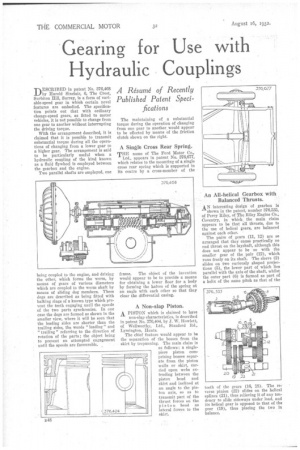Gearing for Use with Hydraulic Couplings
Page 66

If you've noticed an error in this article please click here to report it so we can fix it.
A Resume' of Recently Published Patent Specifications DESORIBED in patent No. 376,468 by Harold Sinclair, 6, The Crest, Surbiton Hill, Surrey, is a form of variable-speed gear in which certain novel features are embodied. The specification points out that with ordinary change-speed gears, as fitted to motor vehicles, it is not possible to change from one gear to another without interrupting the driving torque.
With the arrangement described, it is claimed that it is possible to transmit substantial torque during all the operations of changing from a lower gear to a higher gear. The arrangement is said to be particularly useful when a hydraulic coupling of the kind known as a fluid flywheel is employed between the gearbox and the engine.
Two parallel shafts are employed, one being coupled to the engine, and driving the other, which forms the worm, by means of gears of various diameters which are coupled to the worm shaft by means of sliding dog members. These dogs are described as being fitted with balking rings of a known type which prevent the teeth engaging until the speeds of the two parts synchronize. In one case the dogs are formed as shown in the smaller view, where it will be seen that the leading sides are shorter than the trailing sides, the words " leading " and " trailing " referring to the direction of rotation of the parts ; the object being to prevent an attempted engagement until the speeds are favourable. The maintaining of a substantial torque during the operation of changing from one gear to another would appear to be effected by means of the friction clutch shown on the right.
A Single Gross Rear Spring.
THE name of The Ford Motor Co., Ltd., appears in patent No. 376,677, which relates to the mounting of a single cross rear spring which is supported in its centre by a cross-member of the frame. The object of the invention would appear to be to provide a means for obtaining a lower floor for a body by forming the halves of the spring at an angle with each other so that they clear the differential casing.
A Non-slap Piston.
A PISTON which is claimed to have non-slap characteristics, is described in patent No. 376,404, by J. W. Howlett, of Wellworthy, Ltd., Stanford ltd., Lymington, Hants.
The chief feature would appear to he the separation of the bosses from the skirt by trepanning. The main claim is as follows : a singlepiece piston comprising bosses separate from the piston walls or skirt, carried upon webs extending between the piston head and skirt and inclined at an angle to the piston axis, so as to transmit part of the thrust forces on the piston head as lateral forces to the skirt.
An All-helical Gearbox with Balanced Thrusts.
AN interesting design of gearbox is shown in the patent, number 376,535, of Percy Riley, of The Riley Engine Co., Coventry, in which the main claim appears to be that all thrusts, due to the use of helical gears, are balanced against each other.
The pairs of gears (11, 12) are so arranged that they cause practically no end thrust on the layshaft, although this does not appear to be so with the smaller gear of the pair (12), which runs freely on its shaft. The sleeve (2) slides on two curiously shaped projections (5), the lower part of which lies parallel with the axis of the shaft, whilst the outer part (6) is formed as part of a helix of the same pitch as that of the teeth of the gears (16, 13). The reverse pinion (22) slides on the helical splines (21), thus relieving it of any tendency to slide sideways under load, and its helical gear is opposed to that of the gear (19), thus placing the two in balance.




































































































